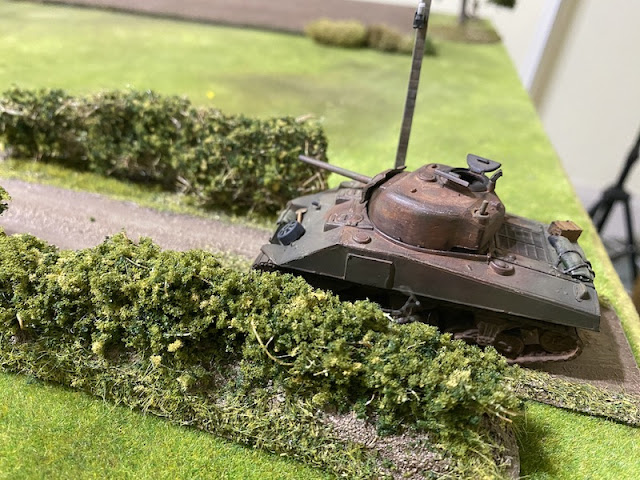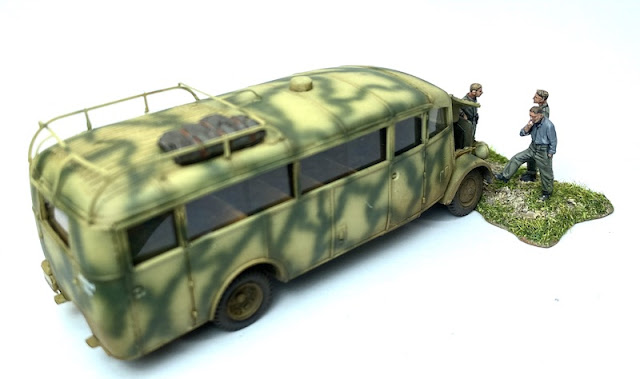I think vehicle wrecks are like casualty figures, they are visual cues to the unfolding narrative of any game or campaign. The more that I record my games here on the blog, the more I see how well those elements help to tell the story and make the experience more immersive. One of the advantages of playing the Second World War in 20mm is the abundance of models and their relative low cost when compared with 28mm. It means I can afford to turn a few into wrecks without breaking the bank, like the PzIV below, a plastic kit from Dragon.
The first wreck I made was a small Panzer II using the old Matchbox kit (see below). I opened up the driver's hatch and added a very simple interior, but other than that this is the kit as it comes out of the box.
The second was a T34 and I decided to try something more ambitious. The old Airfix kits can be picked up very cheaply and I decided to make this one with the turret blown off. The interior elements were scratch built, but not following any precise plans, I just wanted to give the impression of cluttered debris within the tank hull and turret. All I used were odds and ends from the spares box and pieces of plastic card.
Operation Martlet also inspired a knocked out PzIV. The core German panzer grenadier platoon starts with one attached. There was a good chance that might also be destroyed and we would play another game on the same table. I picked up a very nice kit from Dragon that enabled me to make one with most of the hatches in the open position without having to undertake any conversion or cutting of parts.
Once that is dry the tank is sprayed in the colour it would have been prior to being knocked out. Once that is dry you lightly wet the paint and then rub at it with a coarse hair paint brush to expose the colour underneath. It's a surprising simple yet effective technique. You can see this in more detail in this post about making the wrecked T34.
Broken down vehicles or those out of fuel also add to the narrative. The story of a retreat is full of pictures of vehicles abandoned by the side of the road. When we played the Ruckzug campaign I thought that was a perfect opportunity to make up a bus that I had bought with just such a project in mind.
I have a set of plastic panzer crews from Orion and a few of them are in overalls and look like mechanics. I thought a few of them would provide the perfect little vignette to work with the model.
Here it is in one of the Ruckzug campaign games:
A Japanese Isuzu truck model from IBG came complete with an engine and it seemed a shame not to do something similar with that. In this instance I haven't come up with any appropriate Japanese figures for mechanics but I think with the bonnet up and the driver's door wide open it still tells its own story.



























Lovely work. One error, first picture is a Panzer 3, which appears later, but confused me as I was reading the blog. Now you've made me think about wrecks too.
ReplyDeleteThanks, but possibly I’ve confused things with the pictures and text. First one is actually a PzIV, next is a PzII. I suspect it’s not clear from the text so I’ve made a few changes.
DeleteCheers. I'm easily confused.
DeleteExcellent work all round there Mark, particularly the PzIV.
ReplyDeleteThanks Phil, I was particularly pleased with that one. It’s very tempting to over do some of the effects but I did my best to restrain myself.
DeleteYour Panzer IV is one of the best burnt out wrecks yet. While my OCD stops me mixing plastic and metal vehicles in play, I can cope with plastic kits for wrecks as they are 'terrain' in my head and so, according to some rule I don't understand, 'allowed'. For vehicles in play that get knocked out I have replacement open hatches that can be dropped in with flames/smoke coming out and often a ring to be inserted under the turret with more smoke. As my rules that that started my 20mm WW2 collection distinguish whether the tank commander is 'heads up' or 'buttoned up' I had to have separate, drop in, open (with figure) and closed hatches so one more with smoke wasn't that much extra hassle.
ReplyDeleteThanks. I definitely want to come up with a better solution for tanks destroyed in the course of a game. While my fiery plumes look good enough, it’s not how most wrecks look and an absent turret doesn’t quite look right. I’m yet to work out my ideal (and practical) solution.
DeleteOther things you could try are to droop the gun barrel even more - I know there are elevation stops but if the tank's brewed up they could be damaged - alternatively you could raise the gun to its maximum elevation. Another is to make the tank sit lower as the heat of a fire could weaken the suspension or even cause it to fail - this in turn allows you to droop the tracks down between the return rollers (if any) - shed tracks are also an option. Adding several penetrating, and glancing hits, would make it look like its been repeatedly hit - either by mistake or as an insurance policy if the firer wasn't convinced it was U/S. Draping a tarpaulin over the gun barrel or down the side will also add an abandoned look.
DeleteFinally, you could go OTT and make a completely shattered wreck - there are quite a few photos of tanks completely smashed to pieces. Often cited as due to aerial bombs but ko'd tanks were routinely blown up with explosives to prevent them falling into enemy hands by both sides.
Really beautiful and inspiring work!!
ReplyDeleteThanks very much.
DeleteThese are superb. Love the way you've achieved the burnt-out effects and the open hatches give a perfect impression of a hastily abandoned burning tank.
ReplyDeleteThanks, I think open hatches go a long way to telling the story. The good thing about the kit of the PzIV was that nearly all hatches could be modelled open or closed and that saved a lot of fiddly work trying to cut them open.
DeleteNice work. Wrecks on the table do give a great depth to the campaign narrative.
ReplyDeleteThanks - of course the challenge is how many do you need? I have a horrible feeling this could get out of hand!
Deletenur
ReplyDelete